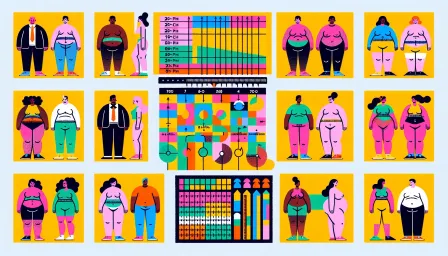Metabolic Rate and Gender: How Your Sex Influences Energy Expenditure

Learn about how metabolic rate and gender are interconnected. This article explores how sex influences energy expenditure and sheds light on relevant studies and insights.
Understanding the nuances of metabolic rate and gender can offer deep insights into how your body processes energy. This article aims to uncover how metabolic rates differ by gender, and how these differences impact energy expenditure in various contexts. Let's explore the scientific explanations behind these physiological variations.
What is Metabolic Rate?
Your metabolic rate is the rate at which your body burns calories to sustain vital functions such as breathing, circulating blood, and maintaining body temperature. It consists of three main components:
- Basal Metabolic Rate (BMR): The number of calories your body needs to perform essential functions at rest.
- Thermic Effect of Food (TEF): The energy required to digest, absorb, and process nutrients consumed.
- Physical Activity Energy Expenditure (PAEE): The calories burned during physical activities and exercise.
These components collectively determine your total daily energy expenditure (TDEE). Understanding the factors that influence these components is crucial for managing weight and overall health.
Factors Influencing Metabolic Rate
Numerous factors influence metabolic rate, including age, body composition, genetics, and gender. While each factor plays a significant role, this article focuses on the impact of gender differences on metabolic rate and energy expenditure.
Gender Differences in Basal Metabolic Rate (BMR)
Research shows that men generally have a higher basal metabolic rate than women. This discrepancy is primarily attributed to differences in body composition:
- Muscle Mass: Men typically have more muscle mass compared to women. Muscle tissue burns more calories at rest than fat tissue, contributing to a higher BMR in men.
- Hormonal Differences: Testosterone, a hormone more prevalent in men, promotes muscle growth. On the other hand, estrogen tends to encourage fat storage, leading to lower BMR in women.
The Role of Body Composition
Even within the same gender, individuals with more lean muscle mass and less body fat tend to have higher metabolic rates. Regular strength training and physical activity can help increase muscle mass, thereby boosting BMR.
Hormonal Influences on Metabolism
Hormones play a pivotal role in regulating metabolism. The effects of hormones like estrogen, testosterone, and thyroid hormones cannot be overstated when discussing metabolic rate differences between genders.
Estrogen and Energy Balance
Estrogen influences fat storage and distribution in women. Higher estrogen levels promote fat accumulation, particularly in the hips and thighs. This fat storage is a biological preparation for potential pregnancy and childbirth. Additionally, estrogen can affect appetite and food intake, contributing to overall energy balance.
Testosterone and Muscle Growth
Testosterone aids in muscle growth and repair. Higher levels of testosterone in men lead to greater muscle mass, which positively impacts BMR. Thus, men generally exhibit higher metabolic rates than women.
Thyroid Hormones and Metabolism
The thyroid gland produces hormones like thyroxine (T4) and triiodothyronine (T3), which regulate metabolism. Any imbalance in thyroid hormone levels can significantly affect metabolic rate in both men and women.
The Impact of Aging on Metabolic Rate
Age-related changes also play a role in metabolic rate differences between genders. As individuals age, they tend to lose muscle mass and gain fat mass, leading to a decrease in BMR. This effect is seen in both genders, but the rate of muscle loss and fat gain can differ.
How Lifestyle Choices Influence Metabolism
Lifestyle choices such as diet, exercise, and sleep can profoundly impact your metabolic rate. Here are some key factors to consider:
Diet and Metabolic Rate
Nutrition plays a critical role in metabolism. A diet high in protein can increase the thermic effect of food, leading to higher energy expenditure. Moreover, balanced diets rich in fruits, vegetables, lean proteins, and whole grains support metabolic health.
Exercise and Muscle Mass
Regular physical activity, especially resistance training, can help increase muscle mass and BMR. Both men and women can benefit from incorporating strength training into their fitness routines to optimize their metabolic rates.
Sleep and Metabolism
Adequate sleep is essential for hormonal balance and metabolic health. Poor sleep quality or insufficient sleep can negatively affect metabolism, leading to weight gain and other health issues.
Strategies to Optimize Metabolic Rate
Understanding the factors that influence metabolic rate can help you make informed choices to optimize your metabolism. Here are some strategies for both men and women:
- Incorporate Strength Training: Engage in regular resistance exercises to build and maintain muscle mass.
- Adopt a Balanced Diet: Eat a diet rich in proteins, healthy fats, and complex carbohydrates to support energy expenditure.
- Prioritize Sleep: Aim for 7-9 hours of quality sleep per night to maintain hormonal balance and metabolic health.
- Stay Hydrated: Proper hydration is essential for optimal metabolic function.
- Manage Stress: Chronic stress can negatively impact metabolic rate, so practicing stress-reducing techniques is beneficial.
Conclusion
Metabolic rate and gender are intrinsically linked, with both biological and lifestyle factors playing critical roles. Men generally have higher metabolic rates due to greater muscle mass and testosterone levels, while hormonal differences and body composition influence women's metabolism. By understanding these differences and implementing lifestyle strategies, both men and women can optimize their metabolic health and energy expenditure.
By recognizing the factors that influence metabolic rate, you can make informed choices to support your overall health and well-being.



























